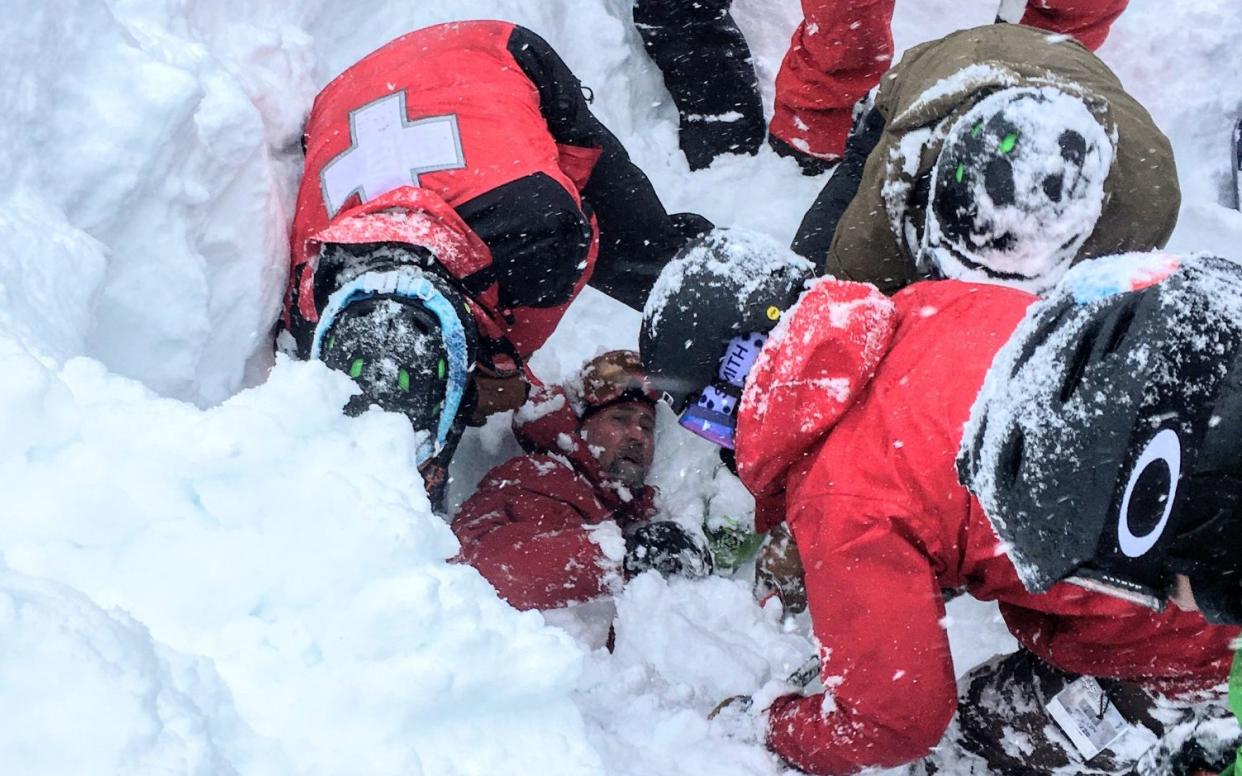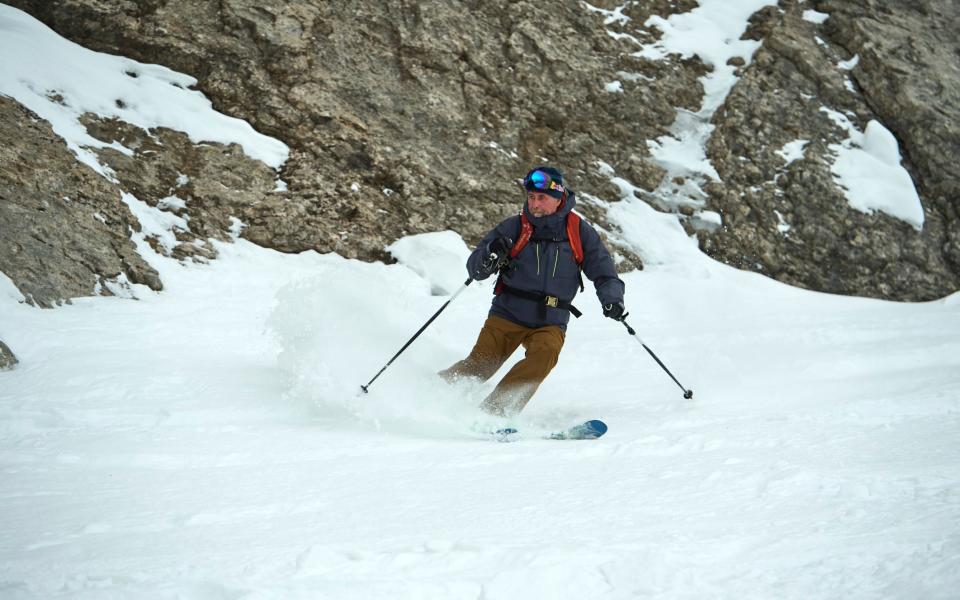‘The snow slid over me and my world went dark’

In North America, it is widely believed that skiing within the ski area boundary is safe, but the recent events at Palisades Tahoe – where three skiers were injured and one died after an in-bounds avalanche – shows, yet again, that it is not always the case.
I was buried 2.8m (9.2ft) deep in an in-bounds avalanche in Idaho for an hour in January 2020, the sort of burial that is usually not survivable. But somehow I’m still here. I say to people: “You don’t want to be me, ever.” You don’t ever want to be caught in an avalanche, and even less, caught in an avalanche without equipment – whether that’s in the resort or off piste.
Recent events have only strengthened my opinion that skiers in the States should have a more European attitude and wear avalanche safety gear, to be adequately prepared for disasters on the slopes – like what happened to me – no matter where you plan to ski. The fact is that despite the heroic efforts of ski patrols, risk remains. Mother Nature doesn’t recognise “in-bounds”, “side country” or “backcountry” and will do as she pleases, so we have to have more respect and change our view of the mountains. They are not amusement parks.

Snowblind to the risks
On Jan 7 2020, my friend Rebecca and I planned to ski a small area called Silver Mountain in Idaho. It is not prone to avalanches because of the gentle topography, and I knew it well. So when Rebecca and I set out, excitement was high.
I’ve worked as a ski patroller at Stevens Pass, a mountain in the US with high avalanche activity, and I’ve worked as a ski instructor and industry rep – in short, I know snow. I should, therefore, have known better than to jump right into the first big storm of the year, not knowing how the snowpack had formed at Silver that winter. But the skiing was so phenomenal, I couldn’t wait. You could say I was snowblind.
That morning, the pistes were deep in powder but with no sign of instability after an hour, so we joined a group traversing Wardner Peak to a designated area that had just opened for the first time that season. We passed a bomb crater – evidence that avalanche prevention work had been carried out – and I said to Rebecca: “Patrol must be comfortable with opening.”
But as Rebecca turned her skis downhill, the entire traverse started to move. All around me the slab was releasing – the snow wasn’t moving fast, but it was deep and it laid me onto my side. I slid downhill as if in a grade 3 rapid, one moment my head was on the surface, next it was under, then up again. I was on my side for about 183m (600ft) before I came to a rest, with everything intact, even my skis, in a small bowl that had no exit.
It was a deadly terrain trap and the avalanche was still coming down: I knew that no matter what I did, there was no escape. The snow that followed me piled up over my head.
Buried alive
It wasn’t my first burial, so when the snow stopped and I could see light, I knew I wasn’t deep. But just 10cm (4in) of sluff (dry, powdery snow) is like cement. I could hear Rebecca screaming for me, and I was somehow able to move my hand and create a hole to the surface. I yelled back that I was fine, but as I lay there, trying to stay calm, a second slide released.
We all know that if the first one doesn’t kill you, the second one will.
As the snow slid over me and my world went dark, I said to myself: “I’m a dead man.” Everything stopped and the crushing weight settled on me – if I hadn’t been lying on my side the snow would have suffocated me, but my ribcage protected my lungs.
When all went quiet, I could only move my eyelashes and toes. Some quick calculations told me I was not in a survivable situation.
Statistically unsurvivable
According to statistics, 93 per cent of avalanche victims can be recovered alive if they’re dug out within the first 15 minutes, but after that, numbers drop catastrophically. After 45 minutes, there’s only a 20 to 30 per cent chance of survival. I was buried for an hour.
I still had all my gear with me – there was no evidence trail of hat, gloves and poles to lead searchers to me. I had no airbag and, crucially, no beacon (transceiver), because we were skiing in-bounds. I didn’t even have a pack with a shovel and probe. Rebecca was the only one who knew where I was and I had no idea if Rebecca was also trapped under the snow.
Being buried alive is indescribably, overwhelmingly terrifying. The memory flashes back to me even now, four years later. I tried to control my breathing – impossible – to conserve as much air as I could, but as time ticked on, distortedly, I thought of my wife and my family and I screamed. I knew it was futile and a waste of oxygen, but there is terror and then there is uncontrolled terror. I wished, with all my being, that I would pass out and this ordeal would be over.
I started to feel warm and comfortable, the early stages of hypothermia, but then felt something touch my hip. I knew it was a probe but then, nothing. I was convinced they’d missed me. But gradually, the pressure on my body lessened, the light was changing, I could hear noise and feel the vibrations of digging. I started screaming again and was still screaming after they’d uncovered me.
There were around 40 people searching the hill, and I’d been found by Silver Mountain’s 70-year-old part-time ski patroller, Joan. I was 2.8 m (9.2ft) down and she found me using a 3m (10ft) piece of electrical pipe, given to her as a makeshift probe for the search. It saved me – commercial avalanche probes are only 2.3m (7.5ft).

The aftermath
Seven of us were caught on Silver Mountain that day. Five were completely buried and three died.
Rebecca was carried 6-9m (20-30ft) downhill and buried to her chest. She dug herself out with her bare hands – she didn’t have a backpack or probe, either. No one realised Molly, one of the three who died, was even missing until the next morning when they found her car still in the car park. Molly was found more than two days later under at least 6m (20ft) of snow.
After the avalanche, I was given the physical all-clear, though I was warned to expect “some PTSD”. And the trauma is still playing out. While buried, I clenched my jaw so hard I cracked my teeth – I’ve lost one molar and other teeth continue to fall apart one at a time. People ask when the reality of what happened sunk in, but it’s still sinking in – even now. You just don’t expect to survive.
Would it have been a different scenario if we’d had avalanche equipment? Possibly.
Live to ski another day
Now, when I see others on the mountains making foolhardy decisions – skiers who go off piste in Europe, even close to the runs, or in the backcountry here in North America, without avalanche equipment – I want to scream. I am the bridge between the survivors and the deceased; I have a responsibility to educate and raise awareness after what I went through.
We need to have a more open dialogue between those trying to create a safe riding experience and all of us using the mountain. It’s great, for example, that Brighton Resort in Utah is currently only open to skiers with avalanche gear, after a week-long storm cycle. But I’m afraid liability issues in resorts – which are legally bound to ensure all areas designated open within the resort are safe to ski – will not allow these conversations to develop.
Like me – and so many of my friends who have been caught or died in avalanches before me – you can have all the avalanche training and experience in the world, but in the end all you can do is avoid an avalanche at all costs. Live to ski another day: have the guts to take the safer route, walk away if you have to. Make the decisions that will allow you to ski again. Trust me, you don’t want to be me.
As told to Abigail Butcher
Rules, regulations and best practices vary on both sides of the Atlantic
North America
“In-bounds skiing” everything within the resort boundary is “snow safe” – avalanche patrolled and stable snow. Still expect some areas to be roped off and closed, particularly after a storm or when snow cover is thin. It doesn’t mean a double black diamond is safe for a beginner, but that there is no requirement to wear avalanche beacons and carry kit. Resort owners are responsible for skier safety inbounds, aside from collisions.
“Off piste” in the US and Canada, confusingly to Europeans, means off the marked trails but within the confines of the resort and is still regarded as “safe”. Resort owners are responsible for skier safety in these areas, aside from collisions.
“Backcountry” (also termed side country/slack country) means outside the designated resort boundary. They are accessed via gates, and skiers are responsible for their own safety. Avalanche beacons, kit and mountain guides are not legally required, but it is foolish to ski without them.
“Ski patrol” only operate within the resort boundaries, securing snow and attending accidents. In the backcountry, if something goes wrong, skiers are reliant on the goodwill of resort ski patrol and/or local volunteers/rescue services, which vary from state to state.
Europe
“On piste” means safe, groomed and surrounding snow secured for skiers travelling within piste markers. There is no requirement to wear avalanche beacons and carry rescue kit. Resorts are responsible for skier safety, aside from collisions.
“Off piste” is the area outside the marked runs, tackled at a skier’s own risk, even if just 1m (3ft) from the run. Avalanche beacons, kit and mountain guides are not legally required, but it is foolish to ski off piste without them.
“Backcountry” is an American term increasingly being used in Europe to describe off-piste areas that are further afield from the resort. The same rules for off-piste skier responsibility apply.
“Ski patrol” work within the resort securing snow and attending accidents on the piste, and areas off the pistes within the ski area. Further away from resort boundaries, mountain rescue/helicopter services are on call for accidents and emergencies.


Recommended
How to stay safe from avalanches when skiing